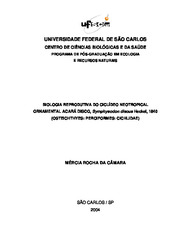Biologia reprodutiva do cíclídeo neotropical ornamental acará disco, Symphysodon discus Heckel, 1840 (Osteichthyes: Perciformes: Cichlidae)
Resumen
The Neotropical cichlid fish red discus, Symphysodon discus Heckel, 1840
originates from the Amazonian basin. Though this species is popularly used in
aquaria and is exported as an ornamental fish, it has not been intensively studied.
As such, this work was carried out with an objective to study the reproductive
biology of this species. Eighty individuals of both sexes of different body sizes
and in different stages of gonadal development were used in this study. The
gonads were examined macroscopically in order to observe the maturation
stages and histological staining was used for microscopic observations. The
fecundity, type of spawning and the gonadosomatic index were determined.
Aggressive interactions and territoriality between mature males of different body
sizes were observed in neutral situation. The results of macroscopic observations
of the gonads of both sexes showed the four stages of gonadal development,
such as, immature, maturing, mature and partially spent. Microscopic
examinations showed five different phases of the ovarian development and four
testicular developmental stages. The average fecundity per batch was 536
oocytes. The gonads of the mature females showed all the different phases of
oocyte development indicating the multiple spawning habit of this species. The
mature males in the reproductive phase manifested aggression, territoriality and
defence of territory, exhibiting differences in body size, degree of aggression and
capacity of territorial defence. The bigger males were more aggressive than the
smaller males. The males with established territories were preferred by the
females for courtship.
